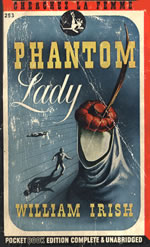Phantom Lady
 Cover Artist:
Cover Artist: Leo Manso
By: Woolrich, Cornell
Publisher: Pocket Books, Inc. (253)
Place of Publication:New York, NY
Catalog #: Kelley Box 836: PS3515 .O6455 P4 1944
Contributor:
R. Brandt
General
Era: 1940s
Author as on Cover: William Irish
Publication:1944
Original Date: 1942
Setting: urban
Plot Summary
Scott Henderson has an argument with his wife, goes out and picks up a woman in a bar wearing a hat that "resembled a pumpkin, not only in shape and size but in color." He invites her to spend the evening with him; she agrees on the condition that they do not exchange names or discuss their personal lives. When Henderson returns home, he finds his wife has been strangled with one of his neckties. All of the evidence points to him as the killer. His only hope is to find the woman who can give him a solid alibi, but she seems to have disappeared. Everyone who can verify that Henderson was with her on the night in question swears that he was alone that night. Henderson is convicted of murder and sentenced to death. His "girl," Carol Richman, and his best friend, Jack Lombard, set out to unravel the mystery of the "phantom lady" and clear Henderson's names before the sentence can be carried out. Burgess, the arresting officer, who has come to believe in Henderson's innocence, assists them.
Major Characters
John Lombard adult male, early 30s, moderately tall, tanned skin, mustache, oil company engineer
Marcella Henderson adult female, beautiful, "doe-eyed," curly hair
Scott Henderson "Hendy," adult male, 32 years old, well-dressed, affluent, in the brokerage business
Carol Richman "The Girl," adult female, pretty, blue eyes, straight taffy-colored hair
Burgess "Burge," adult male, homicide detective
Cliff Milburn adult male, rodent-like, tight skin, flattened hair, mustache, professional musician (trap-drummer)
Pierette Douglas adult female, beautiful, brunette, tall, perfect figure
Estela Mendoza adult female, Hispanic (Argentinean), black eyes, beautiful, intelligent, talented, actress/singer
Weapons
necktie (strangulation); razor; hands and feet; gun
Level of Violence
most of the violence takes place off-stage. The murders of Marcella Henderson, the blind man, and Pierette Douglas (and Cliff Milburn's suicide) are all described after-the-fact. Those descriptions, however, in the form of Burgess recounting the stories to Henderson, are rather graphic. This is especially true in the case of the blind man, whose neck is broken when Lombard stomps on it after he has pushed him down a flight of stairs.
Sexuality
sexuality does not play a significant role. The Hendersons' fight is ignited by the fact that Scott wants a divorce so that he can be free to marry Carol; however, he and Carol agreed not to have an affair.
Gender Roles
male: traditional, female: progressive. Even though the actions of Carol Richman can be seen as traditionally female, the underlying motive for those actions causes her to be progressive. Rather than sit back and wait for someone else to clear Henderson, she acts on her own, and with Burgess's help. She assumes various roles in order to uncover the truth. In fact, she is so crucial to the investigation, that Burgess proclaims her "the best man of us all."
Ethnicity
the only ethnic character in the novel is the popular actress, Mendoza, who is from Argentina. She is portrayed as wealthy, successful, talented, and a bit bossy toward those around her.
Alcohol/Drug Abuse
marijuana: in order to get information out of Cliff Milburn, the trap-drummer, Carol feigns a romantic interest in him. He takes her to a jam session where he and a group of other musicians proceed to get drunk and high on marijuana cigarettes. Woolrich compares the scene to Dante's Inferno and, indeed, for Carol it becomes a personal hell that she endures in order to save the man she loves. The drugs also play a role in the death of Milburn, who slashes his own throat in "a fit of drug-induced depression and fear."
Law Enforcement
law enforcement is represented in the character of homicide detective Burgess. He is Henderson's arresting officer, yet becomes convinced during his trial that Henderson is innocent. He decides that Henderson's alibi is "so lame, so blank" that he must be telling the truth. Since the case is officially closed and he cannot personally investigate, he contacts Henderson's girl, Carol Richman, and his best friend, Jack Lombard, and starts them on the trail of the elusive woman who can clear Henderson.
Added Features
conspiracy: all of the characters in the novel who could testify to the existence of the "phantom lady" are bribed or frightened by Marcella Henderson's real killer into giving false testimony, thus condemning Scott Henderson to death. (Note: the 1982 Ballantine edition includes an introduction written by Francis M. Nevins, Jr.)
Subject Headings
New York (N.Y.)/ Jealousy/ Murder
Psychological Elements
Woolrich uses the names of the chapter titles to add a sense of suspense and frantic fear to the story. Each chapter counts down the number of days until Henderson is executed, a device which translates to Henderson's own fear of being put to death for a crime he did not commit.
Film Adaptations
Phantom Lady, 1944, Universal
 Cover Artist: Leo Manso
Cover Artist: Leo Manso